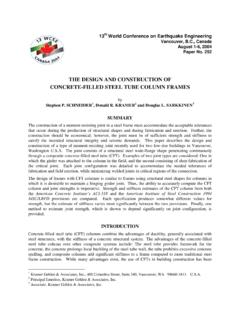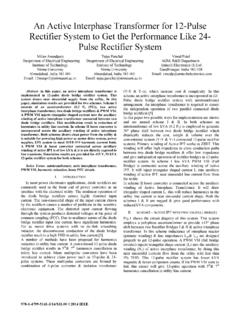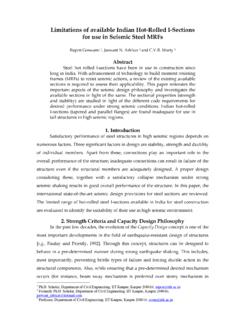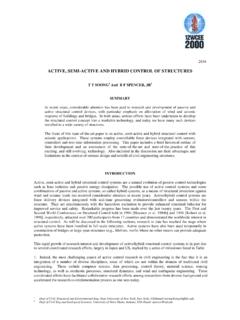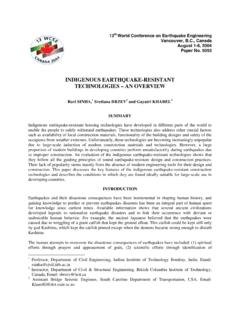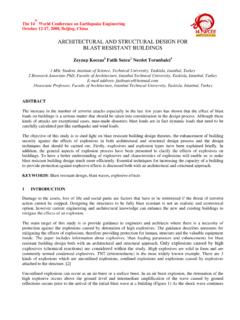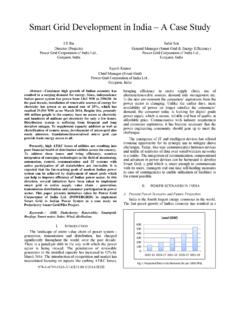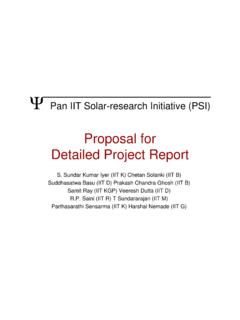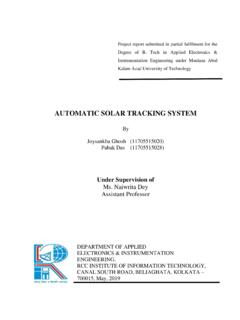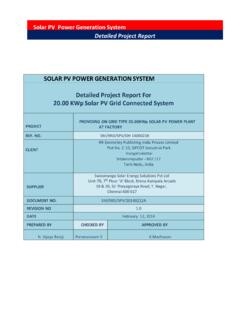Transcription of Proposal for Detailed Project Report
1 Proposal for Detailed Project ReportS. Sundar Kumar Iyer (IIT K) Chetan Solanki (IIT B) Suddhasatwa Basu (IIT D) Prakash Chandra Ghosh (IIT B) Samit Ray (IIT KGP) Veeresh Dutta (IIT D) Saini (IIT R) T Sundararajan (IIT M)Parthasarathi Sensarma (IIT K) Harshal Nemade (IIT G) Pan IIT Solar-research Initiative (PSI)Outline Goal of PSI Overview of initiative Sub-themes in the initiative Organisational structure Proposal for Detailed Project Report Pan IIT Solar-energy Initiative (PSI) 9thJuly, 2008: DST Secretary, calls meeting of representatives from all IITs at Technology Bhavan, New Delhi 19thNovember, 2008: Second meeting called by DST Secretary of IIT representatives at Technology Bhavan, New Delhi 12thJanuary, 2009: Brainstorming at IIT Bombay 22ndFebruary, 2009: Discussion and Finalisation of theme for PSI at IIT Kanpur 18thSeptember, 2009: Discussion on potential work packagesGoal of PSIGoal of PSI1 MW 8 hours per dayPower Generation state of the art PV and solar thermal technologies multiple sources Storage short term and long termSmart Islanded Grid can be connected to the main grid if neededWhy1 MW?
2 Size of SystemMain Challenge/ InnovationRelevance to PSI10s of Watt Cost of system Battery technology Cost, maintenance and replacement of parts More relevant for individual institutes than a Pan-IIT effortkW to 10s of kW Small energy storage technology Solar power conversion efficiency (hence cost of power) Modularity of power conditioners More relevant for individual institutes than a Pan-IIT effort100s of kW Generation at low cost Storage of energy Delivery of energy to consumer Possibility of a Pan-IIT effort. But the issue of scaling and pooling energy from different islanded energy source is not MW + Generating power efficiently and low cost Linking up islands of power generations sources spread out over different pockets Can have islanded grid May be scaled up and/or connected to grid ideal for scaling up With improved energy storage technology, can extend duration of operationWhy 8 Hours?
3 Most industrial and agricultural power needs are during the day Requiring power availability at night (when sunlight is not available) shifts focus and cost of the Project overwhelmingly to energy storageOverview of the InitiativeThe concept: Vertically integrated solar energy initiative for generation and delivery of 1 MW power, 8 hours a dayTHERMALSTORAGEBATELFCMPPTCONSUMERACDC -busH2DC-ACSTORAGEGENS ystem OverviewCONTROLSS ystem SizingLoad profile8hrs/day @1 MW 8 hrs/day @500 kW8hrs/day @250 kW24 hrs/day@20 kWAnnual ene-rgy demand2920 MWh/a1460 MWh/a730 MWh/aComponentsSizeEnergy share(%)SizeEnergy share(%)SizeEnergy share(%)SizeEnergy share(%)PV (kWp)172888864884328811546 Bat (kWh)161078057408742048 Elec (kW)430521551065296H2 stor (m3)@ 200 bar46923411725 Fuel cell (kW)
4 76038019025 Only 5% energy is supplied from long term storageAppendix 2 for more detailsEstimated Component sizes Generation Capacity MWp-1 MWp of solar thermal - 800 kWp of solar PV Storage- MWh of battery storage - 300 kWh solar thermal storage - 50 kW of fuel cell system Sub-themes in the InitiativeGeneration PVGeneration Solar ThermalPower System DesignStorageTo build capacity for 800 kWp Work Package 1: Silicon based solar cellsvalue add: -high efficiency crystalline Si, lowering material cost Work Package 2 : Non-Si based (CdTe and CIGS) thin film solar cells value add: -low cost alternatives to crystalline SiIndustry: -MoserBaer, Tata BP Solar, Hind High Vacuum, and Solar : PhotovoltaicAppendix 3 for more detailsGeneration: ThermalTo build capacity for 1 MWp Work Package: An integrated solar thermal systemvalue add: - Improved solar radiation collection w/ parabolic mirrors- Thermal storage using a solar tower- Storage using thermic fluid (oil) Industry.
5 Saint Gobain and L&TAppendix 4 for more detailsSystem DesignSmart islanded grid, receiving power fromrenewable sources and feeds connected loads Work Packages DC-DC Conversion for Solar PV & Battery charge controller Work packge 2 - DC-AC conversion and grid side paralleling & MPPT Work Package 3- Instrumentation & Communication Work package 4- Power Quality and Network Interactions Value add integrating diverse renewable sources and storageAppendix 5 for more detailsStorageEnsure Reliable power supply Work Packages Battery storage Thermal storage Hydrogen based storageValue add Integrating diverse storage for short term, intermediate term and long term storage Development of Hydrogen Fuel Cells Organisational Structure of PSIO rganizational ChartThemeCoordinatorCo-coordinatorOvera llS Sundar Kumar IyerIIT KChetan SolankiIIT BStorageSuddhasatwa BasuIIT DPrakash Chandra GhoshIIT BGeneration.
6 PhotovoltaicSamit Ray IIT KGPV eeresh DuttaIIT SainiIIT RT SundararajanIIT MSystem DesignParthasarathi SensarmaIIT KHarshal NemadeIIT GAdministrative StructurePower System DesignPSIC oordination teamPowerGenerationPhotovoltaicPower Generation ThermalEnergyStorageDSTWork packagesWork packagesWork packagesWork packagesStructure of PSI Overall Goal Whole team works towards the single goal 1 MW power for eight hours per day Sub-themes (Thermal and PV generation, controls, storage) Coordinators and co-coordinators of sub-theme lead a Pan IIT team Each sub-theme works towards for overall goal Work Packages Each sub-theme is made up of one or more work packages (pillars) Work packages are independent of each other Each work package is vertically integrated contributing decisively to the final goal Work package leader and team (pan-IIT)
7 Work package leader part of the sub-theme teamThe Detailed Project ReportDeliverables of DPR Overview of the Project , logistics, and requirements to implement the Project Pin down technical specifications for every aspect of work package Clear description of work packages under each sub-theme Work package teams and specific responsibility of each team member Clearly specify the innovation the work package brings to the table Identify industrial partners who will implement the innovative aspect of work package on the field Deadline for Submission of DPR30thNovember, 2009 Planned Budget Writing DPR ~ lakhs- Includes meetings of different sub-theme groups- Visits to exisiting power plants - Interaction with expert groupsConcluding remarks Pan IIT Solar Energy Initiative is a critical part of the national mission Success of this initiative will Spur state of the art solar power harnessing across the country Will build pan-IIT teams working on solar energy related technology A Detailed Project Report is being put together by the Pan-IIT YOU!
8 Appendix 1 Background slidesWorld Electricity Generation048121620197519801985199019952 00020052010 YearElectricity Generation trillion kWh/year)worldIndiaData from: Electricity Generation010020030040050060070080019751 980198519901995200020052010 YearElectricity Generation (billion kWh / year)Data from: extrapolationwill mean generationwill be trillion kWhGeneration by 2020 Electricity Generation (per capita)012345678197519801985199019952000 20052010 YearPer Capita Electricity Generation (kWh/day)Data from: and Energy ConsumptionData from: and 0100002000030000400005000060000020406080 100 Per Capital Energy Consumption (kW-hr/day/person)Per Capita Gross Domestic Product(US$ per person) USAL uxemburgNorwayIcelandUAEI relandIndia( , 3290)ChinaUK( , 31150)Quality of Life vs.
9 Energy Usage35004500550065007500850002040608010 0 Per Capita Energy Consumption (kWh per day)Quality of Life IndexIndia( , 5759)Quality of Life Index out of a maximum of 10,000 IcelandIrelandNorwayUSAUAEC hinaData from: and Energy usage needed for good quality of life with today s life-styleUK( , 6917)Potential in Electricity Generation Linear extrapolation trillion kWh Generation by 2020 World per-capita energy generation parity 3 trillion kWh per year (at least) Maximise quality of life index 6 trillion kW per year (at least)How is this electricity to be generated?35 Annual Mean Global IrradianceOn a horizontal plane at the surface of the earthW m-2averaged over 24 hWith 10% efficient solar cell area of solar cell needed in 2004 India 60 km 60 km ( area) Goswami 2000 National Action Plan on Climate ChangeNational Solar Mission: The NAPCC aims to promote the development and use of solar energy for power generation and other uses with the ultimate objective of making solar competitive with fossil-based energy options.
10 The plan includes: Specific goals for increasing use of solar thermal technologies in urban areas,industry, and commercial establishments; A goal of increasing production of photovoltaics to 1000 MW/year; and A goal of deploying at least 1000 MW of solar thermal power objectives include the establishment of a solar research centre, increased international collaboration on technology development,strengthening of domestic manufacturing capacity, and increased government funding and international 30thJune, 2008 Summaryon one of the eight national missions envisioned. document: ..Our vision is to make India s economic development energy-efficient. Over a period of time, we must pioneer a graduated shift from economic activity based on fossil fuels to one based on non-fossil fuels and from reliance on non-renewable and depleting sources of energy to renewable sources of energy.

